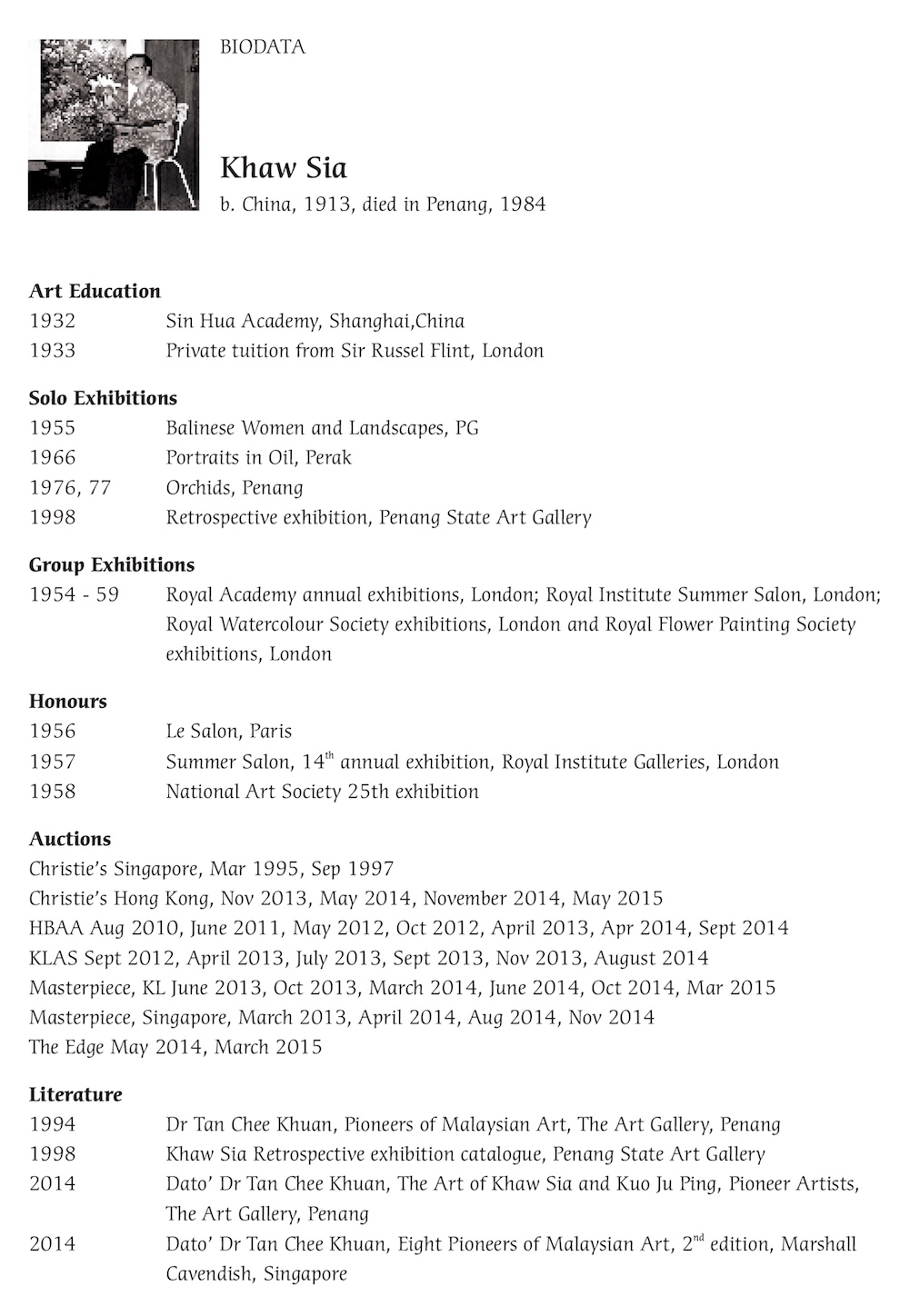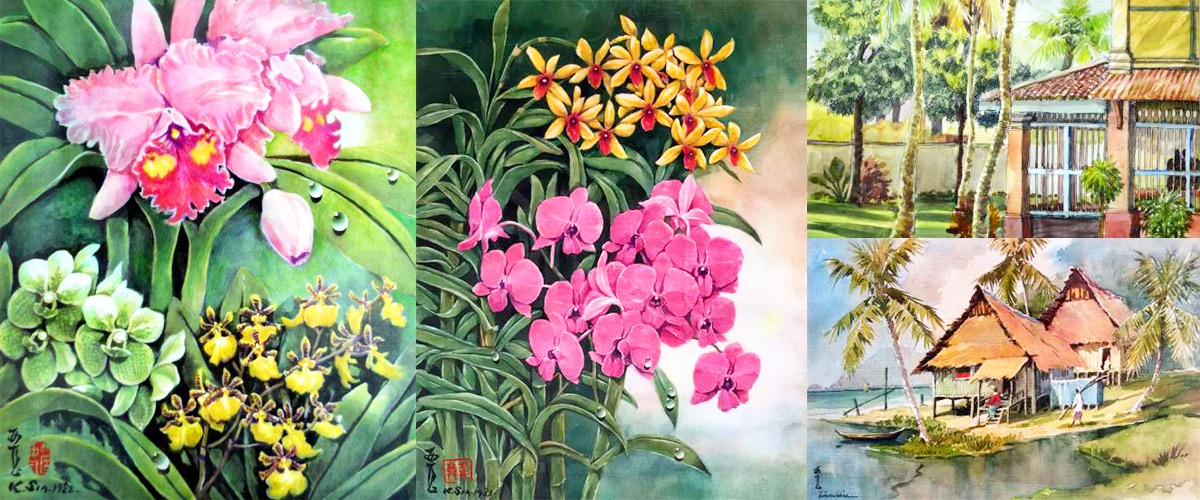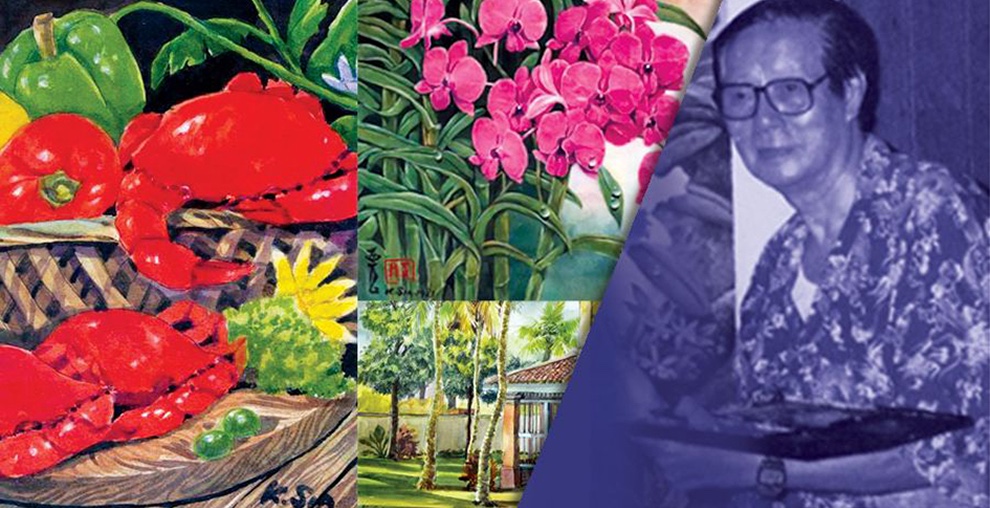The Art Of Khaw Sia
“How to Authenticate Khaw Sia’s Paintings”
Date: 17 May 2015, Sunday
Time: 12.00 p.m. to 5.00 p.m. (Tea Reception)
* Note: No flowers please. Thank you.
If you wish to celebrate with us on this happy occasion, why not buy a copy of the 20 page booklet
How to Authenticate Khaw Sia’s Paintings at RM 10.00 only.
KHAW SIA
Born in China in 1913, Khaw Sia studied at the Sin Hua (New China) Art Academy at Shanghai (1927- 1932). There, he met several famous Chinese brush painters, including Xu Beihong (1895-1953) who praised his talents highly. He did numerous watercolour paintings of landscapes using Chinese brush techniques with bold washes. He filled numerous sketch books with his watercolour studies. Later, he briefly studied under Sir Russel Flint in England in 1933. He received awards for his art at Le Salon Paris (1956), Summer Salon 14th annual exhibition at the Royal Institute Galleries, London (1957), and National Society 25th Exhibition, England (1958). He continued to paint until his death in 1984 at the age of 71 years. His paintings are included in local auction houses in KL, was auctioned by Christies, Singapore before, and recently, was also auctioned by Christies, Hong Kong.
Artist Details

Art Appreciation of Pioneers of Malaysian Art (or Old Masters of Malaysian Art)
It is said that art is a cultural statement that remains to inform and educate future generations of how life once was. This is what makes certain pieces of art more poignant and famous than others, when they come to symbolize a generation or period of time. There are certain works of art that can teach us these invaluable lessons. In this coming exhibition you can have the opportunity to enjoy and view some of the old masters of Malaysian art which focus on Khaw Sia and Kuo Ju Ping, who have captured on canvas and paper many Malaysian scenes and lifestyle for us to be able to enjoy and appreciate.

Who are the Old Masters of Malaysian Art?
In Malaysia, the Old Masters can also be the Pioneer artists whom I have defined as the first generation of Malaysian artists who has contributed to the development of the art tradition in Malaysia and was influential on the art of many younger artists (Eight Pioneers of Malaysian Art, 2013, pg.18). Most of these artists were born before 1925.
Old masters works are characterized by extreme technical and artistic skill using limited tools and a certain sense of distinctive and sometimes haunting beauty which has kept the artwork popular through the centuries. Works of art classified as old masters include Goya, da Vinci, Tintoretto, Raphael, and Vermeer who painted many centuries ago. The art history of Malaysia goes back to the 1900’s and the old masters include Dato Hossein Enas, Abdullah Ariff, Dato Chuah Thean Teng, Khaw Sia, Kuo Ju Ping, Lee Cheng Yong, Dato Tay Hooi Keat, and Yong Mun Sen.
How is the Old Masters market doing in the International Market ?
The Old Masters art market offers tremendous opportunities to buyers. Currently, many of the old masters sales provide buyers with an opportunity to acquire a work steeped in history for just a few thousand dollars. Globally the old masters market is considered somewhat a specialist market and is thriving: Of the top ten auction results in the Old Masters sector, nine were hammered within the last decade (artprice.com/artmarketing … world leader in art market information, 2013).
The Old Masters works is a key segment of the global art market, and one whose value doubled in just two years (between 2009 and late 2011). The prestige of this market is reflected in the very high prices that Old Masters fetch, well above the records in Contemporary art (but still lower than Modern Art prices) : Picasso is more expensive than Rubens for example: in fact there is not a single Contemporary work in the top-10 price range for Old Masters.
Driven by the increasing scarcity of old master pieces in circulation (which has a leverage effect on prices) and the breathtaking dynamism of the Chinese market, the Old Masters segment represents a lucrative activity for auctioneers and just over 10% of total global art market auction revenue. China is by far the world’s strongest Old Masters market: In Asia, the prices of Old Chinese Masters have caught up with the historical figures of European art. Today, 8 of the world’s top 10 Old Masters (ranked by auction revenue between 2011 and 2012) are Chinese. (artprice.com/artmarketing … world leader in art market information, 2013)
On December 8, 2009, a black-chalk Raphael drawing, Head of a Muse, sketched around 1490 hit the auction block at Christie’s in London for $47.9 million, including premium. The sale went down in history as the highest figure ever achieved for a work on paper at auction and the second highest for an Old Masters work at auction, (behind a Rubens masterpiece Sotheby’s sold for $76.7 million in 2002).
Sales in the old masters category have remained remarkably strong, with new buyers hopping on board, a robust private market that’s finally changing with the times, embracing new art fairs and trying to appeal to collectors with contemporary tastes. After all, a fleshy 18th-century nude was, at one point, contemporary, too.
In the first half of 2012, Christie’s reported that Old Masters sales were already up nearly 50 percent from 2011. “Growing economies look more globally to what can be purchased,” says Alexander Bell, the international head of Old Masters paintings at Sotheby’s. “It’s natural that that should also extend to Old Masters, which is a significant component of the global art market.” Then there is, of course, the issue of value. “Wealthy people — they aren’t stupid,” says Scott Reyburn, a London-based journalist who covers the art market for Bloomberg Muse. “And I think some collectors may well be looking at Old Masters purely in terms of value for money. Inherent in any conversation about the Old Masters market is a conversation about its supply, which, by its very nature, is limited.
The market for paintings by Old Masters has historically been one of the least volatile sectors of the global art market. While Old Masters Paintings underwent a severe price correction during 2009 recession, the peak-to-trough drawdown was less severe than it was for most other art market sectors. In 2010 and 2011, there has been a sharp spike in the value of Old Master Paintings. Artworks of this type are now generally trading at levels comparable to their pre-crash highs. This is the international art scene, and it is expected the Asian art market will tend to follow in this trend.
Souren Melikian, writing in the International Herald Tribune, explained the phenomenon well. Buyers were driven by the awareness that these works are unique. Moreover, these areas of the market were not much affected by the consumerist bubble which characterized the contemporary art market, as nouveaux riches fell over one another acquiring bigger, gaudier, and nastier trophies for their oversized homes. As Melikian said, connoisseurs had an opportunity to “take back control of the art market.”
How is the Malaysian Old Masters market?
The above is the current international art scene, and it is expected the Asian art market will tend to follow in this trend. At present, works by many Malaysian pioneer artists are undervalued and considered as excellent opportunity to acquire good paintings at low costs. Artprice.com stated “Currently, many of the old masters sales provide buyers with an opportunity to acquire a work steeped in history for just
a few thousand dollars”.This is also true in Malaysia, where Malaysian art lovers can still acquire an old masters works for a few thousand ringgit. Malaysian collectors will eventually become more aware that rarity and limited supplies will drive prices only one direction … upwards.
The market is currently skewed to contemporary art by younger artists whose works command much higher prices. The old masters (pioneer artists) are relatively undervalued, except for Chuah Thean Teng, Mohd Hoessein Enas and Abdullah Ariff. Works by Yong Mun Sen, Khaw Sia, Kuo Ju Ping and Lee Cheng Yong are relatively undervalued and definitely worth collecting before they are swept away by the tsunami of foreign buyers from Singapore, Indonesia and the art museums, especially Singapore and Japan.


